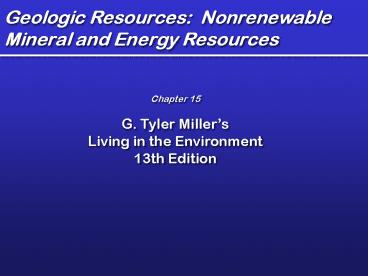Geologic Resources: Nonrenewable Mineral and Energy Resources - PowerPoint PPT Presentation
1 / 19
Title:
Geologic Resources: Nonrenewable Mineral and Energy Resources
Description:
Geologic Resources: Nonrenewable Mineral and Energy Resources Chapter 15 G. Tyler Miller s Living in the Environment 13th Edition NUCLEAR POWER President Dwight ... – PowerPoint PPT presentation
Number of Views:233
Avg rating:3.0/5.0
Title: Geologic Resources: Nonrenewable Mineral and Energy Resources
1
Geologic Resources Nonrenewable Mineral and
Energy Resources
Chapter 15 G. Tyler Millers Living in the
Environment 13th Edition
2
NUCLEAR POWER
- President Dwight Eisenhower, 1953, Atoms for
Peacespeech. - Nuclear-powered electrical generators would
provide power too cheap to meter. - Between 1970 and 1974, American utilities ordered
140 new reactors for power plants.
3
Nuclear Power
- After 1975, only 13 orders were placed for new
nuclear reactors, and all of those were
subsequently cancelled. - In all, 100 of 140 reactors on order in 1975 were
cancelled. - Construction costs, declining demand for
electrical power, safety fears - Electricity from nuclear power plants was about
half the price of coal in 1970, but twice as much
in 1990.
4
How Do Nuclear Reactors Work
- Most commonly used fuel is U235, a naturally
occurring radioactive isotope of uranium. - Occurs naturally at 0.7 of uranium, but must be
enriched to about of 3. - Formed in cylindrical pellets (1.5 cm long) and
stacked in hollow metal rods (4 m long). - About 100 rods and bundled together to make a
fuel assembly. - Thousands of fuel assemblies bundled in reactor
core.
5
How Do Nuclear Reactors Work
- When struck by neutrons, radioactive uranium
atoms undergo nuclear fission (splitting)
releasing energy and more neutrons. - Triggers nuclear chain reaction.
6
Nuclear Fission
7
How Do Nuclear Reactors Work
- Reaction is moderated in a power plant by
neutron-absorbing solution (Moderator). - In addition, Control Rods composed of
neutron-absorbing material are inserted into
spaces between fuel assemblies to control
reaction rate. - Cadmium or boron
- Water or other coolant is circulated between the
fuel rods to remove excess heat.
8
PWR
9
Small amounts of radioactive gases
Waste heat
Electrical power
Steam
Useful energy 25 to 30
Generator
Turbine
Hot water output
Condenser
Pump
Pump
Cool water input
Waste heat
Black
Pump
Water
Waste heat
Water source (river, lake, ocean)
Periodic removal and storage of radioactive
wastes and spent fuel assemblies
Periodic removal and storage of radioactive
liquid wastes
10
RADIOACTIVE WASTE MANAGEMENT
- Until 1970, the US, Britain, France, and Japan
disposed of radioactive waste in the ocean. - Production of 1,000 tons of uranium fuel
typically generates 100,000 tons of tailings and
3.5 million liters of liquid waste. - Now approximately 200 million tons of radioactive
waste in piles around mines and processing plants
in the US.
11
Radioactive Waste Management
- About 100,000 tons of low-level waste (clothing)
and about 15,000 tons of high-level (spent-fuel)
waste in the US. - For past 20 years, spent fuel assemblies have
been stored in deep water-filled pools at the
power plants. (Designed to be temporary.) - Many internal pools are now filled and a number
plants are storing nuclear waste in metal dry
casks outside.
12
Radioactive Waste Management
- US Department of Energy announced plans to build
a high-level waste repository near Yucca Mountain
Nevada in 1987. - Facility may cost between 10 and 35 billion, and
will not open until at least 2015.
13
Decommissioning Old Nuclear Plants
- Most plants are designed for a 30 year operating
life. - Only a few plants have thus far been
decommissioned. - General estimates are costs will be 2-10 times
more than original construction costs.
14
CHANGING FORTUNES
- Public opinion has fluctuated over the years.
- When Chernobyl exploded in 1985, less than
one-third of Americans favored nuclear power. - Now, half of all Americans support
nuclear-energy. - Currently, 103 nuclear reactors produce about 20
of all electricity consumed in the US.
15
NUCLEAR FUSION
- Nuclear Fusion - Energy released when two smaller
atomic nuclei fuse into one large nucleus. (Sun) - Duterium and tritium, two heavy isotopes of H
- Temperatures must be raised to 100,000,000o C and
pressure must reach several billion atmospheres. - Advantages
- Production of few radioactive wastes
- Elimination of products that could be made into
bombs - Fuel supply that is larger and less hazardous
than uranium.
16
NUCLEAR FUSION
- Despite 50 years and 25 billion, fusion reactors
have never produced more energy than they
consume!
17
Nuclear Energy
- Fission reactors
Fig. 15-35 p. 366
- Uranium-235
- Potentially dangerous
- Radioactive wastes
Refer to Introductory Essay p. 338
18
Dealing with Nuclear Waste
- Low-level waste
- High-level waste
- Underground burial
- Disposal in space
- Burial in ice sheets
- Dumping into subduction zones
- Burial in ocean mud
- Conversion into harmless materials
Fig. 15-40 p. 370
19
Nuclear Alternatives
- Breeder nuclear fission reactors
- Nuclear fusion
- New reactor designs
Storage Containers
Fuel rod
Primary canister
Ground Level
Overpack container sealed
Unloaded from train
Personnal elevator
Air shaft
Nuclear waste shaft
Underground
Buried and capped
Lowered down shaft
Fig. 15-42 p. 376































